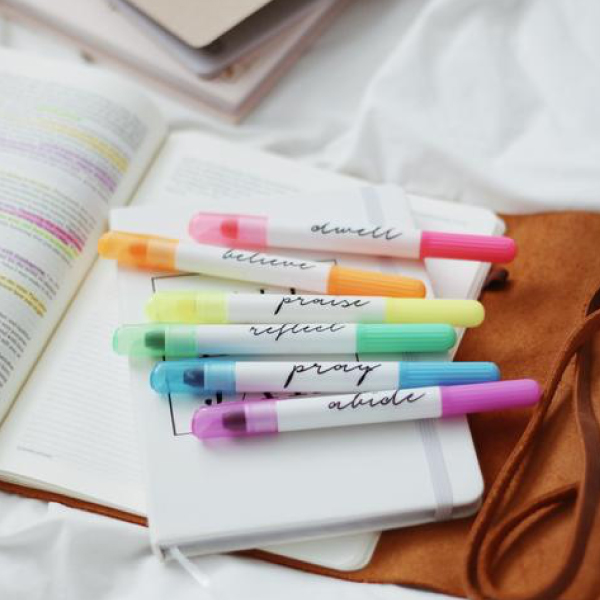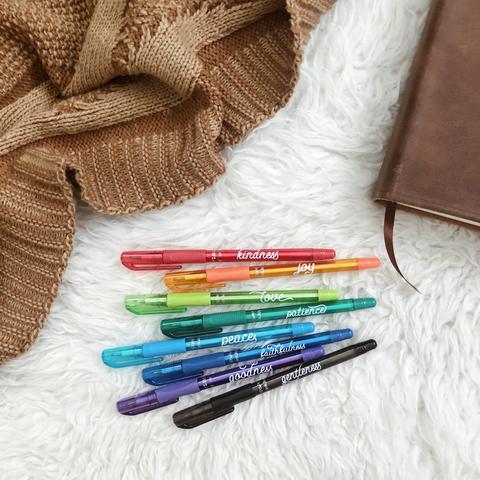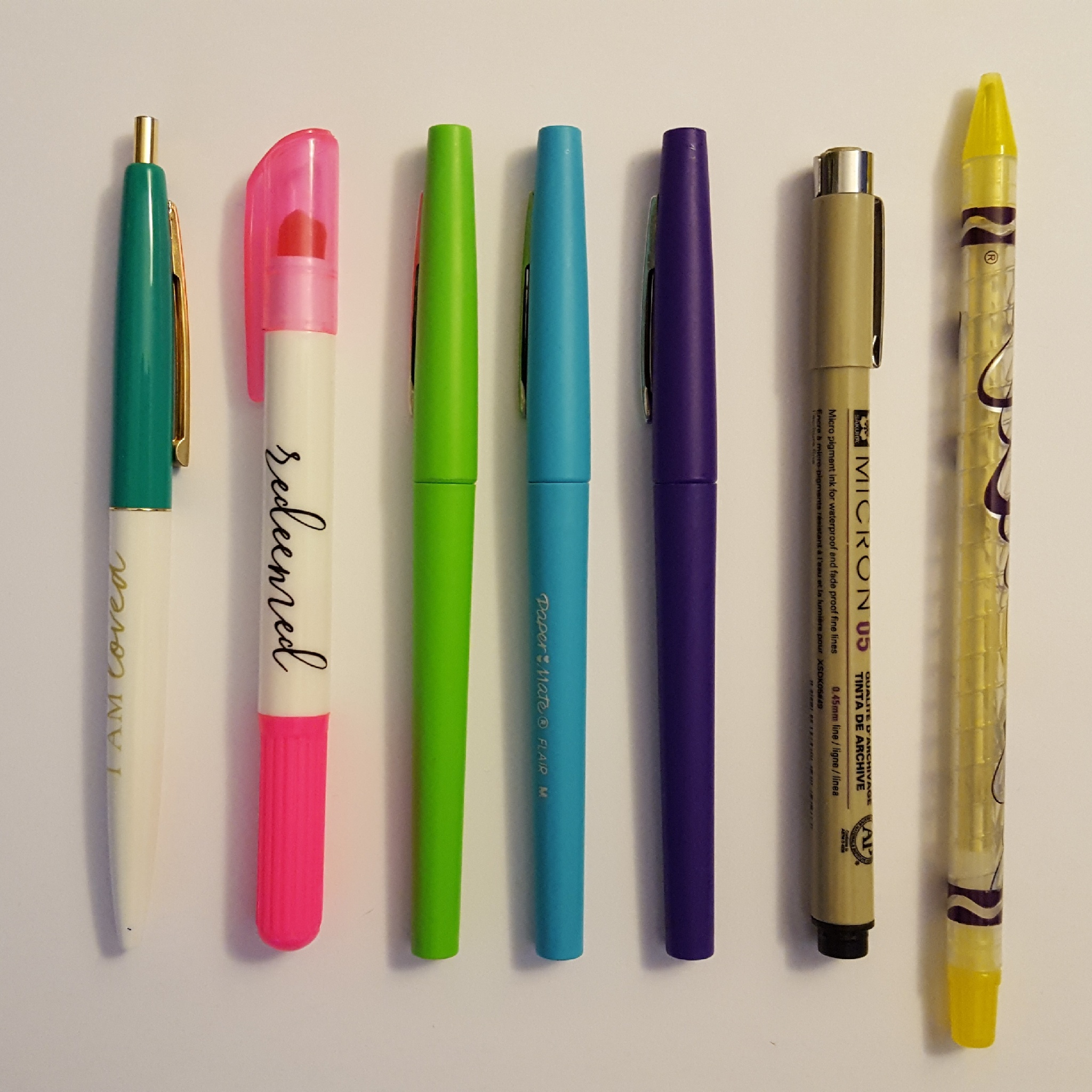**Some of the links below are affiliate links*, meaning, at no additional cost to you, I will earn a commission if you click through and make a purchase. Read my full disclosure here.**
The highlighter was blue, and I held it with a slightly unsteady hand. It had taken me a bit to work up the nerve the finally mark in my Bible. My lines were uneven, and I might have thought for a moment the whole Bible should be trashed because of the squiggly blue lines. Shouldn’t marks in my Bible be perfect? But then I just smiled down at the page with the verse highlighted in blue.
I was young the first time I wrote in my Bible–probably late children’s church, early youth group days young–and that was my first brave step to marking up my Bible for life.
Now I just can’t stop.
Every time I crack open my Bible I have a black Bic pen sitting nearby. Sometimes some colored pencils or gel highlighters. Always something.
This whole marking-up-the-Bible thing has become one of a handful of things I am convinced will grow anyone’s relationship with God and their love for his Word. Over and over again I encourage women to put down the fear of messing up and pick up a pen to mark up their Bible.
Let me assure you right here and now: marking up your Bible will not mess up your Bible. And today I’d like to share why it matters that you write in your Bible, and a few ways to get your started or expand your marking repertoire.
Why you should mark in your Bible
I have a handful of Bibles on my bookshelf. An old student Bible from when I leveled up from children’s church to youth group. My first adult study Bible, an NASB Life Application*, a hardback that used to wear a bright yellow and lavender Bible cover, but now sits naked. A One year Bible*, a couple of ESV journaling Bibles*, and the thinline* that carried me through most of college and a few years into my “real adult” years.
Each one is special to me, and though there have been times I’ve tried to figure out how to get rid of them–because I’m the type of person regularly purging my space of things I don’t use, need, or like anymore–I always end up sliding them back onto my shelf after I peak inside at all the notes.
These Bible, just as much as the tub of journals sitting in my closet, document seasons of my life and seasons in my relationship with God. I’ve marked verses that stood out to me. There are places where my college Bible falls open to without encouragement–Romans 8, John 15, Psalm 139–and are covered in notes, prayers, connections, and various other markings and colors.
My Bibles are private and I always get a little squeamish when someone asks to borrow one, because what are they going to find in there? I write all over my Bibles, recording an ongoing conversation with my Father. What page will they flip to? What notes will they see?
Finding the freedom to mark in my Bibles made all that possible.
My Bibles and the notes inside became spiritual markers of places where God showed up and spoke, when he called or promised or finally made that passage clear after so many reads.
My Bibles have become a place of conversation, where I can read God’s Word and talk back to him right in that passage, on the very same page.
My Bibles have also become a record of God’s faithfulness–of verses I underlined and committed to heart, and looking back over old notes now, I can see the growth since then. It’s like a spiritual scrapbook.
I know for many, marking in the Bible is a scary thing. We don’t want to mess up, we’re afraid of doing it wrong, and if we’re honest, we even wonder if it’s allowed.
It is.
God’s Word is meant to be interacted with and absorbed, not just passively read.
I promise you, you will get more out of it, make more connections, and encounter God even more readily as you read with a pen in your hand.

How to mark in your Bible
If you were to crack open any two of my Bibles, the markings would all look different. I’ve tried different methods over the years, for different Bibles, different seasons, and different studies. Here are the main ways I’ve marked up Scripture pages. Find one that you like and give it a go (but just pick one for now. You can always bookmark or pin this post and come back later to try a different method!):
Basic underline: This is the easiest method to get started with. Grab a pen or pencil, any color, and simply mark whatever verses stick out to you.
Margin notes: Whether you have a journaling Bible with the wide lined margins or an average Bible, writing things in that space around the text is a great way to enter into conversation. I’m not currently using a Bible with wide margins, so I usually write my notes up the side of the page. Not a lot of words, just a quick thought, connection, or realization. If I hear God giving me any insight, I’ll right that down. I also know of quite a few people who use the margin to record main points from a sermon on that particular passage, or who include the date of when they studied that passage.
Key words: Instead of marking an entire verse, underlining or marking the key words helps draw attention to words that are used multiple times in a passage, or short phrases that especially stick out. This is super handy when you’re doing a word or topical study*.
Color code: Color coding is something I tried out for the first time last year. It is really good for studying particular topic, word, or theme throughout Scripture. You assign each topic to a color (this could be a highlighter, colored pencil, or pen) and then every time you come across that topic, theme , or word, you mark it in that color.
My dad has one Bible where he used this method of marking for a year. He calls it his coloring Bible, and he was focused on the different names of God. Each name had a different color and now you can flip through it and see all the instances he came across each of those names. If you’re looking for some colored tools to help you mark up your Bible, I really like the Gel Highlighters and the Color Code Pen set from Daily Grace Co*. They won’t bleed through your Bible pages and they are beautiful colors.


If you’re not sure what topics to look for, there are plenty of color code keys out there. Living Free Indeed has a great breakdown of the colors she uses and the topics she tracks.
Symbols: This method works the same way as color coding, except you assign symbols instead of a colors. This works well if you don’t want to keep track of multiple marking tools, and is frequently the method I use along with basic underlining. I’m normally a one pen kind of girl, so I keep that handy and use my symbols.
Artwork and doodles: This method is truly deserving of post all it’s own, and is popularly known as Bible journalling, but we’ll talk about it briefly here. For the more creative and visual minded, creating artwork or doodles in the margins is a great way to meditate on a certain passage of scripture and create a visual representation of what you read. I have a separate Bible I do this in occasionally and use water colors and Micron pens. If you want to do more reading about this, all you have to do is type Bible journaling into Google and you’ll get plenty of results. I personally like Scribbling Grace’s resources.
Post-its: And lastly, if you’re still uncertain about actually marking on your Bible pages, post-it’s are a great tool. They allow you to make notes to leave in the passage, but keep your pages clean. And you can always remove them later if you want.
However you choose to do it, marking in your Bible is a valuable practice that will help you better connect with God’s Word by not only reading, but studying and entering into conversation with the Lord.
What Bible marking method do you use or are you planning to use?
Related: 5 Great Resources for Daily Bible Study
Live in his love!

Looking for some help to study the Bible for yourself? You can access my free library of bible studies and other helpful resources here. Or sign up for my weekly email devotional.



I might try color coding with my new Bible. Great idea! I write worship song lyrics in the margins of my Bible too—usually IHOP, Jason Upton, Misty Edwards, or Bethel. Thanks for the inspiring post!
I’m curious about what symbols you use. I’ve tried several different ways of marking my Bible and settled on symbols a few years ago. Color didn’t work for me – there aren’t enough colors to differentiate all the topics, and besides that I found color too distracting when I was reading.
Great question! I typically don’t use color either for the same reasons. I’m pretty big on underlining passages that stick out. I will use boxes for repeated words, names of God, or a specific theme I’m tracking. I tend to use stars for verses I want to commit to memory, and I draw a cross next to verses pointing to Jesus.
Hi, I just want to let you know that God loves you and I think you should grow a stronger relationship with the Lord. He love’s you!! That’s all I wanted you to know. Have a blessed day folks.